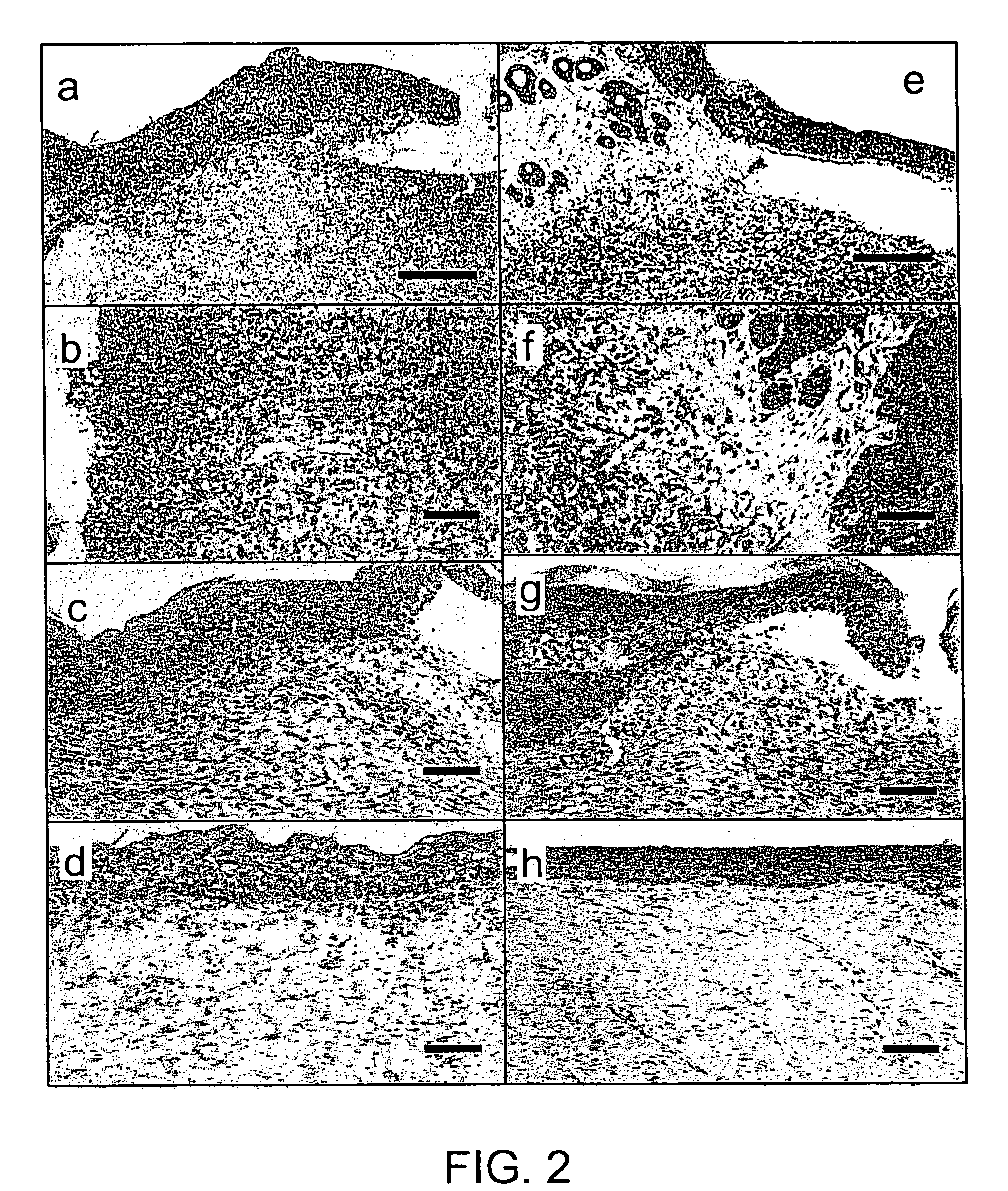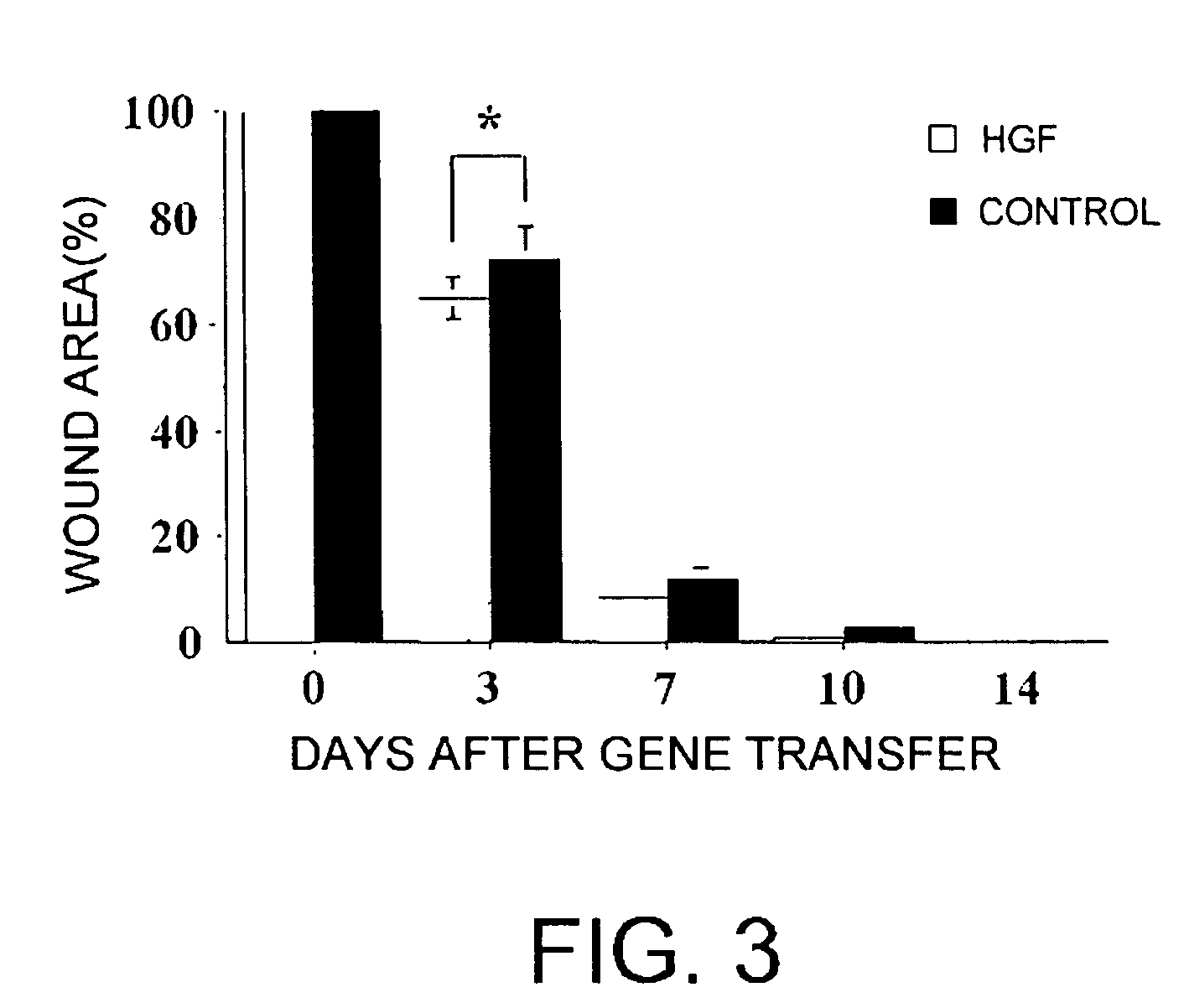[0019]With these results, the present inventors demonstrated that direct administration of an angiogenic factor gene to a skin diseases-affected area is extremely effective. Specifically, it was found that in skin wounds, administration of an angiogenic factor gene yields effective results.
[0031]The term “VEGF gene,” as employed herein refers to a gene that can express VEGF (VEGF
protein). Specifically, such a gene is exemplified by VEGF cDNA incorporated into appropriate expression vectors (e.g. non-viral vectors, viral vectors) such as those mentioned below. Due to selective splicing during transcription, there are four subtypes of the VEGF gene in humans (VEGF121, VEGF165, VEGF189, and VEGF206) (Science, 219, 983 (1983); J. Clin. Invest., 84, 1470 (1989); Biochem. Biophys. Res. Commun., 161, 851 (1989)). Any of these VEGF genes can be used in the present invention. However, the VEGF165 gene is preferred as its
biological activity is the strongest of the VEGF genes. The VEGF gene can also be readily cloned by one skilled in the art, based on the sequences described in the literature (Science, 246, 1306 (1989)) and the sequence information registered in databases. Modification of the VEGF gene can also be easily carried out.
[0032]The terms “FGF gene” and “HIF gene” as employed herein refer to genes that can express FGF and HIF respectively. Such genes are exemplified by genes incorporated into appropriate expression vectors (e.g. non-viral vectors, viral vectors) such as those mentioned below. Such genes can also be readily cloned by one skilled in the art, based on the sequences described in known literature and sequence information registered in databases. Modifications of these genes can also be easily carried out.
[0057]Specifically, administration to the skin diseases site can be carried out intravascularly, intramuscularly, and such, as well as by administration to surface
layers with ointments and such Therefore, at the sites of wounds, baldness, decubitus ulcers (bedsores), keloids,
atopic dermatitis, and skin grafts such as
autotransplantation and crosstransplantation,
angiogenesis in the affected area is enhanced, and
blood flow is improved by intravascular and intramuscular administration using a
syringe or
catheter, or by surface application using an ointment or such. In this way, the function of the affected area can be recovered and normalized.
[0058]Application of an HGF gene of the present invention by active
gene transfer allows treatment of wounds, baldness, skin ulcers, decubitus ulcers (bedsores),
scars (keloids),
atopic dermatitis, and
skin damage following skin grafts such as
autotransplantation and crosstransplantation, and enables
functional recovery in patients for whom conventional therapeutic methods are not an appropriate option. A therapeutic or preventive agent of the present invention contains an angiogenic factor gene in an amount sufficient to accomplish the objectives intended by the pharmaceutical agent, i.e. it contains an
angiogenesis gene in a “therapeutically effective amount” or a “pharmacologically effective amount”. A “therapeutically effective amount” or “pharmacologically effective amount” is an amount of pharmaceutical agent required to produce the intended pharmacological results, and is the amount required to relieve the symptoms of the patient to be treated. Assays useful in confirming the effective dose for a particular application include methods for measuring the degree of
recovery from target diseases. The amount that should actually be administered varies depending on the individual being treated, and is preferably an amount optimized to achieve the desired effects without marked side effects.
 Login to View More
Login to View More 


